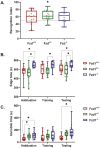A conserved role for frizzled in sleep architecture
- PMID: 38033424
- PMCID: PMC10684271
- DOI: 10.1093/sleepadvances/zpad045
A conserved role for frizzled in sleep architecture
Abstract
Previous studies of natural variants in Drosophila melanogaster implicated the Wnt signaling receptor frizzled in sleep. Given that the Wnt signaling pathway is highly conserved across species, we hypothesized that frizzled class receptor 1 (Fzd1), the murine homolog of frizzled, would also have a role in sleep. Using a CRISPR transgenic approach, we removed most of the Fzd1 coding region from C57BL/6N mice. We used a video assay to measure sleep characteristics in Fzd1-deficient mice. As Wnt signaling is known to affect visuospatial memory, we also examined the impact of the deletion on learning and memory using the novel object recognition (NOR) paradigm. Fzd1-deficient mice had altered sleep compared to littermate controls. The mice did not respond differently to the NOR paradigm compared to controls but did display anxiety-like behavior. Our strategy demonstrates that the study of natural variation in Drosophila sleep translates into candidate genes for sleep in vertebrate species such as the mouse.
Keywords: Drosophila melanogaster; Wnt signaling pathway; mus musculus; novel object recognition test; open-field test; sleep.
Published by Oxford University Press on behalf of Sleep Research Society 2023. This work is written by (a) US Government employee(s) and is in the public domain in the US.
Figures



References
-
- Reid KJ, Martinovich Z, Finkel S, et al. . Sleep: A marker of physical and mental health in the elderly. Am J Geriatr Psychiatry. 2006;14:860–866. doi: 10.1097/01.JGP.0000206164.56404.ba - DOI - PubMed
-
- Colten H. R., Altevogt B. M., eds. Sleep Disorders and Sleep Deprivation: An Unmet Public Health Problem The National Academies Collection: Reports funded by National Institutes of Health. Washington, D. C.: The National Academies Press, USA; 2006. - PubMed
LinkOut - more resources
Full Text Sources
Molecular Biology Databases
Research Materials

